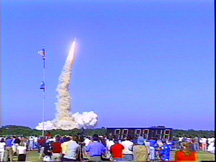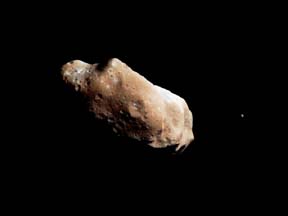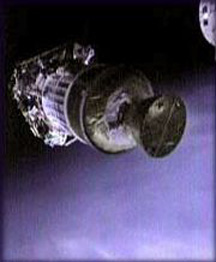The Chandra X Observatory shortly after being released by Columbia.
Click on image for full size
Courtesy of NASA
Columbia Finally Delivers!
News story originally written on July 23, 1999
After failing to launch on two previous attempts, the Space Shuttle Columbia finally took off on July 23, 1999, from Kennedy Space Center. The commander is Eileen Collins, the first woman to ever lead a mission into space.
Hours later, the crew completed its main mission: putting the Chandra X Observatory in space. The telescope will study distant objects like quasars for at least 5 years. The Chandra is expected to rival the Hubble Space Telescope.
There was a lot of pressure on NASA to make this attempt successful. If Columbia had not launched on this try, it would have been delayed until August, or possibly next year.
You might also be interested in:

NASA revealed a few of the many images that will come from its newest telescope. Since first being deployed July 23, the Chandra X Observatory has had no problems. It first made a series of engine firings,
...more
It was another exciting and frustrating year for the space science program. It seemed that every step forward led to one backwards. Either way, NASA led the way to a great century of discovery. Unfortunately,
...more
The Space Shuttle Discovery lifted off from Kennedy Space Center on October 29th at 2:19 p.m. EST. The weather was great as Discovery took 8 1/2 minutes to reach orbit. This was the United States' 123rd
...more
A moon was discovered orbiting the asteroid, Eugenia. This is only the second time in history that a satellite has been seen circling an asteroid. A special mirror allowed scientists to find the moon
...more
Will Russia ever put the service module for the International Space Station in space? NASA officials want an answer from the Russian government. The necessary service module is currently waiting to be
...more
A coronal mass ejection (CME) happened on the Sun early last month. The material that was thrown out from this explosion passed the ACE spacecraft. The SWICS instrument on ACE has produced a new and very
...more
J.S. Maini of the Canadian Forest Service called forests the "heart and lungs of the world." This is because forests filter air and water pollution, absorb carbon dioxide, release oxygen, and maintain
...more















